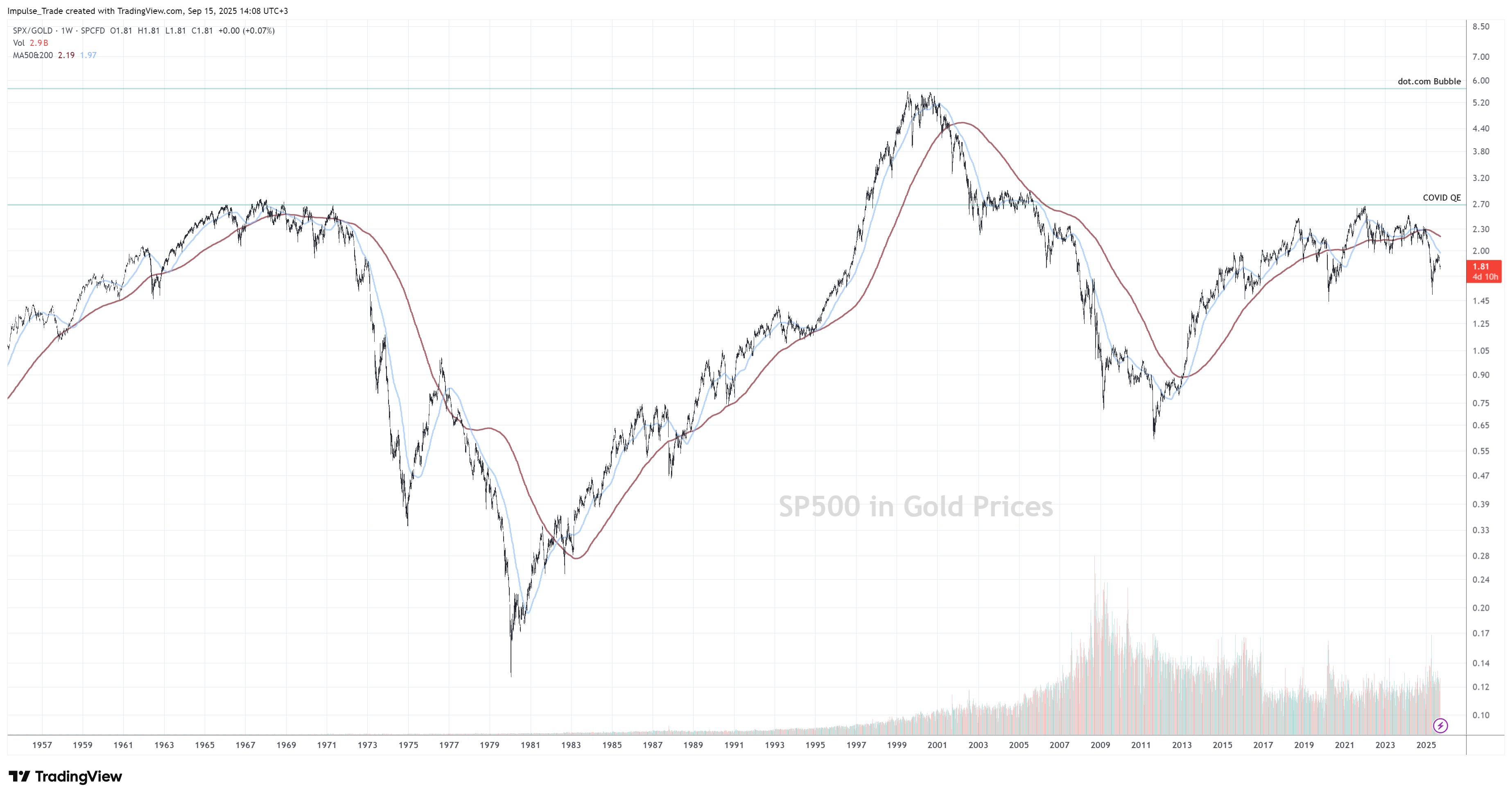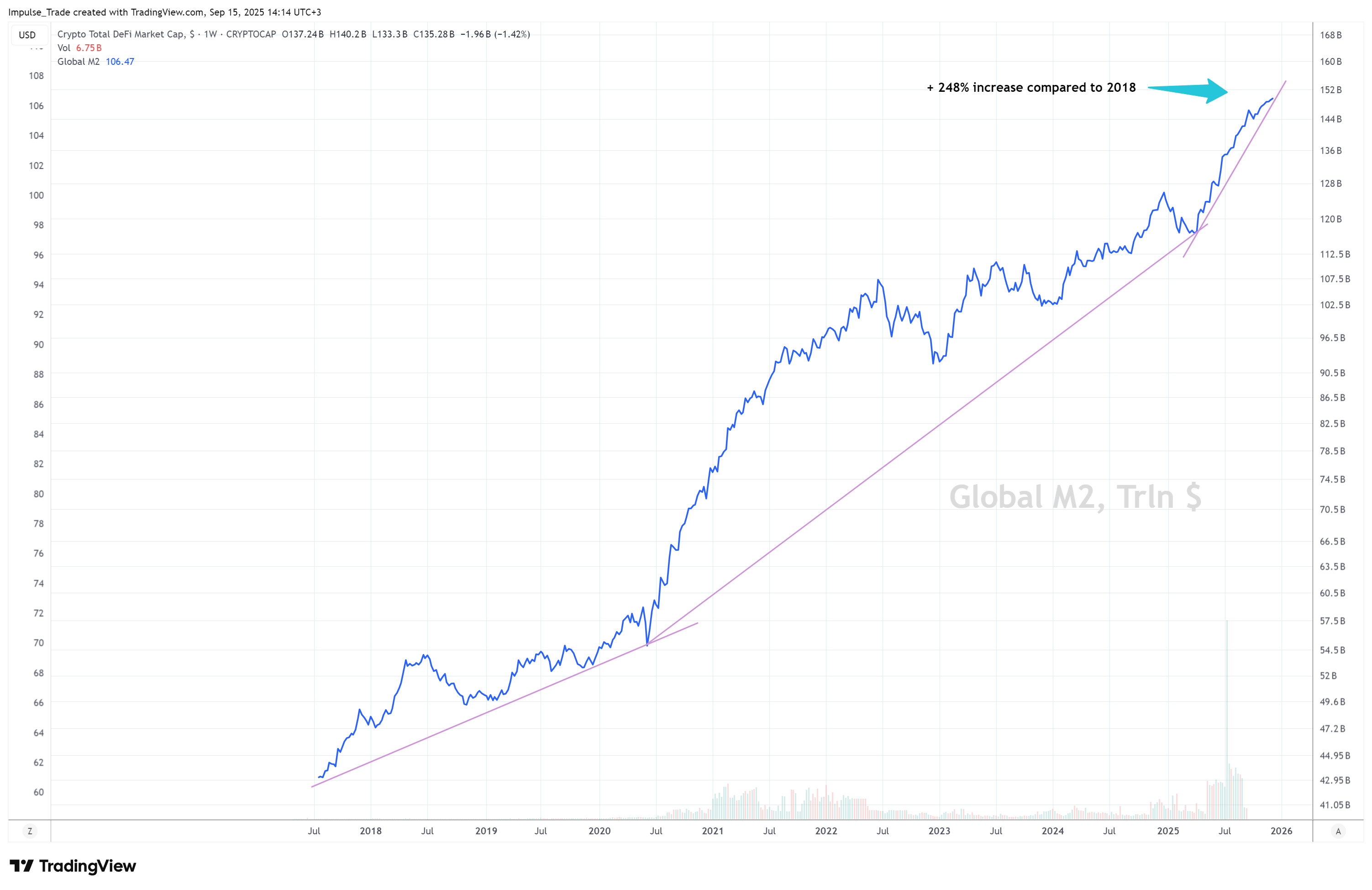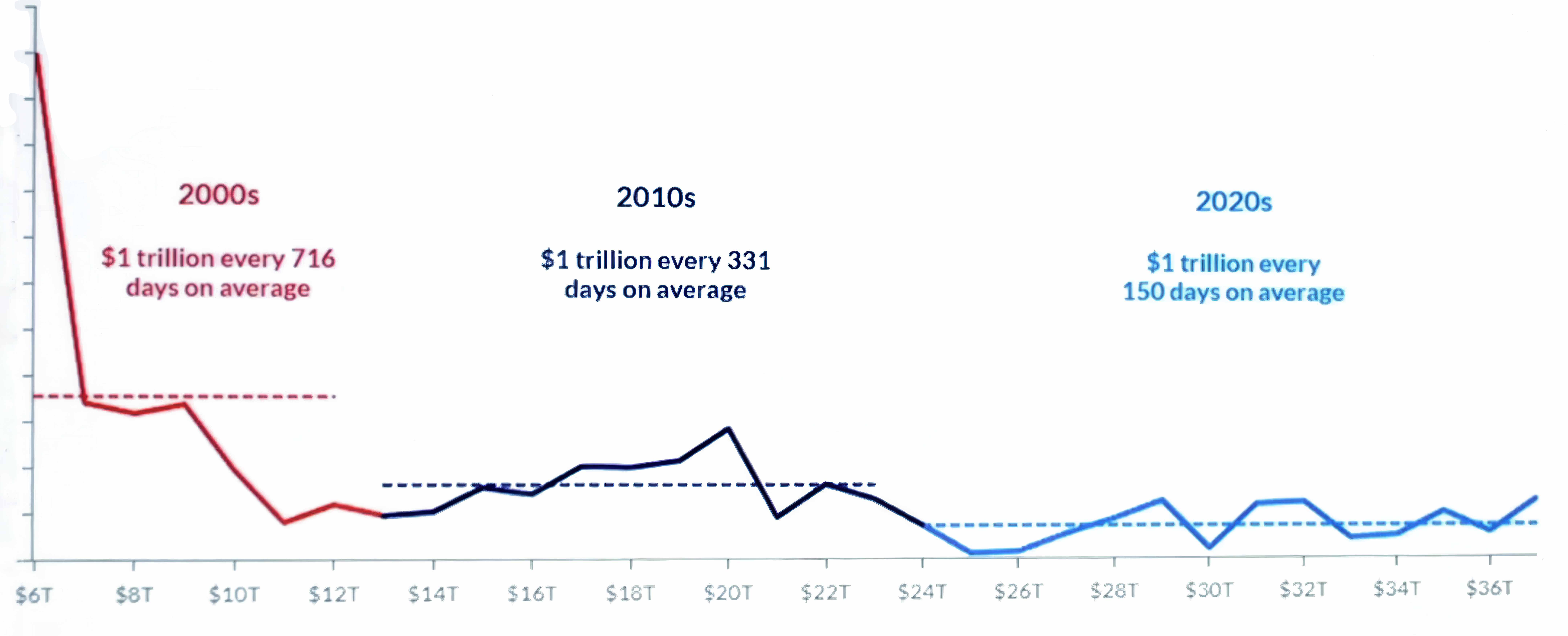CRACKUP BOOM OR GLOBAL MELT-UP
PUBLISHED: 2025-09-19
CATEGORY: Market Analysis
A crack-up boom is an extreme economic scenario where hyperinflation and currency devaluation spiral out of control, leading to a frenzied rush to spend money before it loses all value. Now economy is not in this phase, however some trends and features are already present. How can we hedge ourselves against this phenomenon and how close we are to such scenario?
This article tires to examine the notion and provide some guidelines on how to preserve wealth and keep up with inflation trying to get ahead of inflation and currency devaluation.
crack-up boom by mises
"If once public opinion is convinced that the increase in the quantity of money will continue and never come to an end, and that consequently the prices of all commodities and services will not cease to rise, everybody becomes eager to buy as much as possible and to restrict his cash holding to a minimum size.
For under these conditions the regular costs incurred by holding cash are increased by the losses caused by the progressive fall in purchasing power. The advantages of holding cash must be paid for by sacrifices which are deemed unreasonably burdensome. This phenomenon was, in the great European inflations of the '20s, called flight into real goods (Sachwerte) or crack-up boom (Katastrophenhausse)."
This is the quote from Austrian economist Ludwig von Mises and his work “Crack-up boom”, where he described a rapid increase in the money supply that leads to runaway inflation, eroding confidence in the currency and triggering a collapse in its value. The term captures the final stage of an inflationary cycle, where the public’s expectation of ever-rising prices spirals out of control, leading to economic chaos.
In essence, Mises describes how, once the public believes that money supply growth will persist indefinitely, they anticipate relentless price increases. This triggers a rush to spend money quickly on goods, assets, or anything that holds value, minimizing cash holdings. This behavior accelerates inflation, increases the velocity of money, and can lead to a collapse of confidence in the currency, culminating in a crack-up boom.
Mises argued that a crack-up boom is the inevitable result of unchecked monetary expansion. Once the public loses faith in the currency’s ability to hold value, no amount of further money printing can restore stability—it only accelerates the collapse. The only remedy is to halt money creation and restore sound monetary policy, though this often comes too late.
Misconception of everything is at ATH
Now we can hear that many economists now say that SP500, BTC as well as other assets are on all time high (ATH) and we should consider switching to safe assets. So here is the point that we should take into consideration when saying such things.
Let me ask you, assets are on ATH measured in what? In US dollars? But as far as we already know, USD is always loosing its purchasing power. So why not to choose an asset that keeps its purchasing power and compare stocks or indexes with this asset.

And as we can expect, gold is the best measure for this. Now let us show SP500 chart that is measured not in USD, rather in Gold. As we can see on the chart below the market is not oversold at all, rather it is holding average values compared to dot com bubble and recent COVID QE.

This all happens because gold is trying to keep pace with global M2, that is how much money is being printed in the world.
A good indication of that something is expensive is if it is at ATH in gold prices. So we can just take an asset price and divide by gold to see the location of price at present and compare it to previous values.
As we can see on the second chart there is a whapping 218% increase in all the money in the world since 2018. The slope is becoming steeper and steeper, which means that at the same period of time, they print more and more money.
To elaborate on the topic, we can present the M2 increase in days of $1 trillion. As you can see in 2000s it took about 716 days on average to add $1 trillion to the system, while a decade later it took only about 331 day on average. Now in 2020s it takes only 150 days to add $1 trillion.

This shows that that slope of the curve is rising, however as we all understand it is limited to 90 degrees in theory. But long before it goes to 90 degrees money will become worthless.
Now most educated people understand this phenomenon; however, the rest are living pay-check by pay-check every year struggling with the worsening situation.
The notion: rich are getting richer while poor are getting poorer is very much at practice nowadays as almost all rich people hold their money in assets that cover inflation and monetary abundance by its price appreciation.
Poor people at the same time try to keep up with inflation and constant rise in prices, while their salary is not rising as fast as prices. In order to survive poor need to take credit which makes their life even worse, because paying interest is more burdensome.
Stages of crack-up boom and modern application
In order to understand where we are at present, we need to study stages that lead to crack-up boom. In modern economic theory you may also hear the term “everything bubble”.
Stage 1. Excessive Money Supply Growth
Central banks or governments print money or expand credit excessively, often to finance deficits, stimulate the economy, or cover debts. This devalues the currency over time.
In modern history we see that every year M2 rises and the slope of the curve steepens, which devalues currency more rapidly.
Stage 2. Inflationary Expectations
As the public observes rising prices, they anticipate further inflation. This leads to behaviors like: hoarding goods when people buy goods now to avoid higher prices later, driving up demand and prices further.
Reduced savings when holding cash becomes less attractive as its purchasing power erodes, so people spend or invest in tangible assets (e.g., real estate, commodities). Wage-price spirals when workers demand higher wages to keep up with rising costs, which businesses pass on as higher prices, perpetuating inflation.
Stage 3. Loss of Confidence in Currency
As inflation accelerates, trust in the currency collapses. People may abandon it for alternatives (e.g., barter, foreign currencies, or assets like gold), leading to a velocity of money spike where money circulates faster as no one wants to hold it.
Stage 4. Economic Collapse
The "crack-up" occurs when the currency becomes nearly worthless, economic transactions break down, and the financial system collapses. This can lead to hyperinflation, social unrest, and a need to reset the monetary system (e.g., issuing a new currency).
Modern Relevance
While full crack-up booms are rare, recent concerns about money supply growth (e.g., U.S. M2 expansion during 2020-2022) have sparked discussions and economic forums about inflationary risks. However, advanced economies with strong institutions (e.g., Federal Reserve, ECB) typically intervene with tighter policy before reaching this stage. For example, the Fed raised rates in 2022-2023 to curb inflation from 9.1% to around 3%.
At the same time now, we face the economic dilemma when inflation is creeping up while labor market weakens every month. This may lead to stagflation when more and more people are fired while inflation goes up. Usually when labor market is weak inflation falls, because people spend less and prices go down, however now the situation is different as government prints more and more money.
It is however true to say that not so many people understand what is happening economically because lack of knowledge and proper education do not allow them to see the whole picture.
This thesis can be proved by observing trends in gold and silver purchases during the last and current year. Most volumed is made by institutional investors, mostly central bank and commercial banks. If we look at retail market it is still calm, purchases of silver and gold among individuals are rare and volumes are small.
This illustrates that we are nowhere near the inflection point of crack-up, however all the factors point to the direction.
There are some historical examples of the crack-up boom, nevertheless they are all extreme and far from current situation.
Historical Examples
Weimar Germany (1921–1923): Post-World War I, Germany printed money to pay reparations, causing hyperinflation. Prices doubled every few days, and people used wheelbarrows of cash for basic purchases. The Reichsmark became worthless, leading to social and economic collapse.
Hungary (1945–1946): Post-World War II, Hungary faced war reparations, reconstruction costs, and political instability. The government printed pengő to cover deficits, leading to the worst hyperinflation in history. The money supply grew exponentially, with the Hungarian National Bank issuing notes up to 100 quintillion pengő (100,000,000,000,000,000,000). By mid-1946, new denominations were printed daily.
Prices doubled every 15 hours at the peak (July 1946), with inflation reaching 41.9 quadrillion percent per month. Cash became useless, and people carried bags of notes for basic purchases. The public abandoned the pengő for barter, foreign currencies, or commodities like gold and cigarettes. Businesses indexed prices to stable assets, and workers demanded daily wage adjustments.
In August 1946, the pengő was replaced by the forint, stabilized by gold reserves. The hyperinflation destroyed wealth and trust in the monetary system.
Yugoslavia (1992–1994): The breakup of Yugoslavia, combined with war, sanctions, and economic collapse, led to massive budget deficits. The government printed dinars to finance operations. The money supply grew by trillions percent, with new denominations issued frequently. By 1994, notes reached 500 billion dinars.
Inflation peaked at 313 million percent per month in January 1994, one of the highest recorded. Prices doubled daily, and the dinar became worthless. People bartered, used Deutsche Marks, or hoarded goods. Businesses indexed prices to stable currencies, and savings were obliterated.
In 1994, the dinar was replaced with the “super dinar,” pegged to the Deutsche Mark, stabilizing the economy temporarily. The crisis contributed to ongoing regional instability.
Zimbabwe (2000s): Excessive money printing to fund government spending led to hyperinflation, peaking at 79.6 billion percent monthly in 2008. The Zimbabwean dollar was abandoned, and foreign currencies were adopted.
Venezuela (2010s–2020s): Mismanagement and money printing caused hyperinflation, with annual rates exceeding 1,000,000% by 2018. Citizens resorted to barter or cryptocurrencies, and the bolívar lost all practical value.
Hedges and how to act
Hedging against dollar devaluation requires strategies that preserve wealth in scenarios of inflation, currency depreciation, or economic instability. Below, I outline the best hedges based on economic principles, historical performance, and current sentiment (as of September 2025), while considering Ludwig von Mises’ crack-up boom framework, where loss of confidence in a currency drives a flight to real goods.
These assets or strategies historically perform well when fiat currencies lose value, offering protection against inflation or depreciation:
Gold and Precious Metals
Gold is a traditional store of value, retaining purchasing power during inflation or currency crises. It’s a “real good” in Mises’ terms, sought during crack-up booms (e.g., Weimar Germany, where gold held value as the Reichsmark collapsed).
Gold prices rose from $1,800/oz in 2020 to $3,600/oz in 2025, a 100% gain, outpacing inflation. Silver and platinum also hedge but are more volatile.
How to Invest: Metal bank accounts, Physical gold (bars, coins), ETFs (e.g., GLD), or mining stocks (e.g., Newmont).
Bitcoin and Cryptocurrencies
Bitcoin is often called “digital gold” due to its fixed supply (21 million coins) and decentralization, making it resistant to fiat devaluation. It’s increasingly used in hyperinflationary economies (e.g., Venezuela).
Among its benefits are: decentralization; limited supply; growing adoption (e.g., ETF approvals in 2024). However, it is still highly volatile, regulatory risks still remain and it is energy-intensive.
How to Invest: Direct purchase (via Coinbase, Binance), Bitcoin ETFs, or crypto index funds.
Real Estate
Real estate retains value during inflation, as property prices and rents often rise with costs. It’s a tangible asset, aligning with Mises’ flight to real goods.
U.S. home prices rose ~40% from 2020–2025 (per Case-Shiller Index), outpacing inflation. Commercial real estate (e.g., warehouses) also performed well. Among advantages in real estate investing are: rental income; inflation-linked appreciation; tax benefits.
However, disadvantages are the following: Illiquid; high entry costs; sensitive to interest rates, not all real estate behaves the same, depending on location, type of building, amortization etc.
Commodities (e.g., Oil, Agriculture, Metals)
Commodities rise with inflation, as they’re priced in USD but driven by global demand. They’re “real goods” that people hoard in currency crises (e.g., Zimbabwe’s commodity bartering).
For example oil prices rose from ~$50/barrel in 2020 to ~$80 in 2025; agricultural commodities (e.g., wheat) spiked during 2022 supply shocks. Copper and other metals track industrial demand.
You can invest via commodity ETFs (e.g., DBC), futures, or commodity-linked stocks.
Foreign Currencies
Holding assets in stable or appreciating currencies (e.g., Swiss franc, Singapore dollar) protects against USD depreciation. Foreign equities or bonds diversify risk.
The USD weakened ~10% against a basket of currencies (DXY index) from 2020–2025 peaks, making CHF or SGD holdings attractive. Emerging market equities outperformed USD assets in some periods.
However, risks are also at play, such as volatility; geopolitical risks; transaction costs. It is rather easy to buy such assets through your bank directly on the current account, via forex accounts, ETFs on currency or tokenized currencies.
Conclusion
Ludwig von Mises’ concept of the crack-up boom remains a powerful warning about the dangers of unchecked monetary expansion and unanchored public expectations. While the global economy in September 2025 is far from a crack-up boom, echoes of Mises’ theory are visible in public concerns about inflation, debt, and currency stability.
Historical examples like Weimar Germany and Zimbabwe underscore the catastrophic potential of these dynamics, but strong institutions and proactive policies in major economies provide a buffer. Moving forward, careful monetary and fiscal management will be critical to preventing the conditions Mises described, ensuring that inflationary expectations remain contained and confidence in currencies endures.
Disclaimer: This statement does not constitute financial advice. The information provided is for informational purposes only and should not be considered as investment advice. If you require financial advice, please consult with our certified financial consultants who can offer personalized guidance based on your specific financial situation.
#melt-up #boom #crack-up #inflation